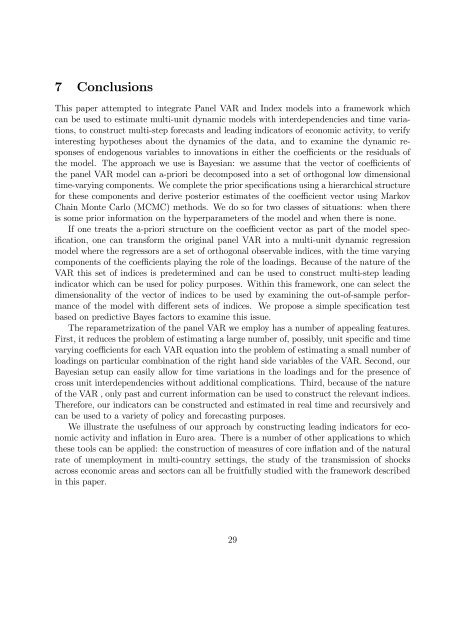PANEL INDEX VAR MODELS: SPECIFICATION, ESTIMATION - Ivie
You also want an ePaper? Increase the reach of your titles
YUMPU automatically turns print PDFs into web optimized ePapers that Google loves.
7 Conclusions<br />
This paper attempted to integrate Panel <strong>VAR</strong> and Index models into a framework which<br />
can be used to estimate multi-unit dynamic models with interdependencies and time variations,<br />
to construct multi-step forecasts and leading indicators of economic activity, to verify<br />
interesting hypotheses about the dynamics of the data, and to examine the dynamic responses<br />
of endogenous variables to innovations in either the coefficients or the residuals of<br />
the model. The approach we use is Bayesian: we assume that the vector of coefficients of<br />
the panel <strong>VAR</strong> model can a-priori be decomposed into a set of orthogonal low dimensional<br />
time-varying components. We complete the prior specifications using a hierarchical structure<br />
for these components and derive posterior estimates of the coefficient vector using Markov<br />
Chain Monte Carlo (MCMC) methods. We do so for two classes of situations: when there<br />
is some prior information on the hyperparameters of the model and when there is none.<br />
If one treats the a-priori structure on the coefficient vector as part of the model specification,<br />
one can transform the original panel <strong>VAR</strong> into a multi-unit dynamic regression<br />
model where the regressors are a set of orthogonal observable indices, with the time varying<br />
components of the coefficients playing the role of the loadings. Because of the nature of the<br />
<strong>VAR</strong> this set of indices is predetermined and can be used to construct multi-step leading<br />
indicator which can be used for policy purposes. Within this framework, one can select the<br />
dimensionality of the vector of indices to be used by examining the out-of-sample performance<br />
of the model with different sets of indices. We propose a simple specification test<br />
based on predictive Bayes factors to examine this issue.<br />
The reparametrization of the panel <strong>VAR</strong> we employ has a number of appealing features.<br />
First, it reduces the problem of estimating a large number of, possibly, unit specific andtime<br />
varying coefficients for each <strong>VAR</strong> equation into the problem of estimating a small number of<br />
loadings on particular combination of the right hand side variables of the <strong>VAR</strong>. Second, our<br />
Bayesian setup can easily allow for time variations in the loadings and for the presence of<br />
cross unit interdependencies without additional complications. Third, because of the nature<br />
of the <strong>VAR</strong> , only past and current information can be used to construct the relevant indices.<br />
Therefore, our indicators can be constructed and estimated in real time and recursively and<br />
can be used to a variety of policy and forecasting purposes.<br />
We illustrate the usefulness of our approach by constructing leading indicators for economic<br />
activity and inflation in Euro area. There is a number of other applications to which<br />
these tools can be applied: the construction of measures of core inflation and of the natural<br />
rate of unemployment in multi-country settings, the study of the transmission of shocks<br />
across economic areas and sectors can all be fruitfully studied with the framework described<br />
in this paper.<br />
29

















